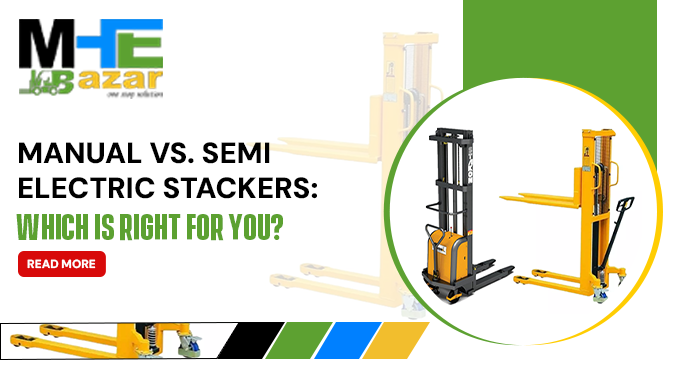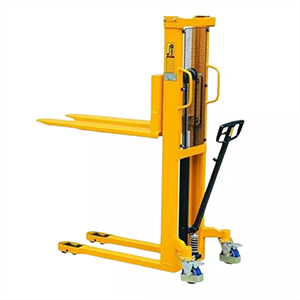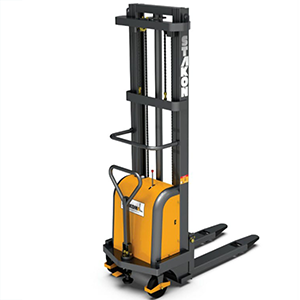1. Introduction
Effective material handling machinery is crucial to the success of any warehouse or logistics operation. Workflow
can
be streamlined, labor expenses can be decreased, and productivity can be greatly increased with the correct pallet
stacker machine. Selecting the right stacker lift type, whether manual or semi-electric, may have a
significant impact on small to mid-sized organizations. In order to assist you in choosing the best stacker machine
for warehouse usage, we will evaluate manual and semi-electric stackers, examine electric
pallet stackers and specialized alternatives, and provide advice such as a stacker buying guide, a comparison of
lifting capacities, and pricing insights.
Who Supposed to read this? The people who stand to gain the most from optimizing warehouse operations are logistics
specialists, warehouse managers, MHE operators, and small-to-mid-size business owners.
2. What Are Manual Stackers?
Definition & Operation
A hydraulic manual stacker uses a lever‑powered
hydraulic pump to lift loads. Operators manually push or pull the stacker into place and use a foot or hand lever to
raise the forks.
Common Use Cases
- Light‑duty applications
- Small warehouses or production floors
- Occasional stacking tasks
- Operations with strict budget constraints
Pros
- Lower upfront cost
- No electric power needed---no batteries, cables, or charging infrastructure
- Simple design ensures easy, low-cost maintenance
- Ideal for quick, light stacking tasks
Cons
- High physical effort required---can lead to operator fatigue over time
- Limited lifting capacity (typically up to 1,500 kg / 3,300 lb)
- Snap‑slow lift speed compared to powered alternatives
3. What Are Semi-Electric Stackers?
Definition & Operation
A semi‑electric
pallet lifter features battery-powered lifting, while leaving horizontal movement manual. Operators use
electric power to lift loads and push the stacker manually.
Ideal for Medium‑Volume Operations
Perfect for businesses seeking energy and labor efficiency without the price tag of a fully electric model.
Pros
- Reduces physical strain---lifting is handled by electricity
- Faster and smoother lift cycle
- Typically supports higher lifting heights
- Moderate upfront cost, still more affordable than fully electric models
Cons
- Requires battery charging infrastructure
- Slightly higher maintenance costs
- Moderate upfront cost---not as low as manual stackers
4. Manual vs. Semi‑Electric Stackers: Side‑by‑Side Comparison
| Feature |
Manual Stacker |
Semi‑Electric Stacker |
| Power Source |
Manual hydraulic |
Electric lift, manual move |
| Effort Required |
High |
Moderate |
| Upfront Cost |
Low |
Mid‑range |
| Maintenance |
Minimal |
Moderate (batteries + electronics) |
| Lifting Height |
Up to ~2--3 m |
1.6m to 3m |
| Lifting Capacity |
Up to 1,500 kg (~3,300 lb) |
Typically 1,000--2,000 kg |
| Ideal Use Cases |
Light use, infrequent tasks |
Medium‑volume, frequent lifts |
| Operational Speed |
Slow |
Faster lifting |
| Operator Fatigue |
High |
Moderate to low |
Quick Rundown:
- Choose manual stackers for low-frequency, budget-sensitive operations with light loads.
- Opt for semi-electric stackers when you need to improve efficiency, reduce fatigue, and uplift
taller or heavier loads.
5. Other Types of Stackers to Consider
If your needs extend beyond basic manual or semi-electric models, explore these other options:
Fully Electric Stackers
- Fully electric (lift + movement)
- Best for high-frequency, heavy-duty warehouse operations
- Lowest physical effort---complete electric control
- Requires battery maintenance and charging
Self-Lifting Stackers
- Designed to be self-loading into trucks
- Great for mobile operations, deliveries, and multi-site use
- Reduces need for dock ramps or forklifts
Electric Straddle Leg Stackers
- Straddle legs add stability; forks can straddle pallets
- Suitable for closed pallets or half-pallets
- Ideal for narrow aisles where stability is key
Fork Reach Electric Stackers
- Features extendable/reach forks for racking
- Perfect in high-rack
warehouses with deep storage
- Electric reach provides accuracy in stacking
Manual Drum Stackers
- Specialized for 225 L drums -- lifting, tilting, transporting
- Used heavily in chemical, oil, pharmaceutical sectors
- Manual hydraulic lifts, often with safety features
6. How to Choose the Right Stacker for Your Needs
When selecting a stacker machine for warehouse, consider:
Load Capacity
Know your heaviest pallet weight and ensure the stacker's capacity exceeds this alone (safety margin 1.2×
recommended).
Lifting Height
Measure highest rack or surface---manual stackers typically lift up to ~3 m; semi-electric and electric reach
heights
of 4--5 m easily.
Frequency of Use
- <10 lifts/day → Manual may suffice
- 10--50 lifts/day → Semi-electric preferred
- 50+ lifts/day → Consider fully electric
Aisle Width & Facility Layout
- Tight aisles? Look at straddle or reach stacker types.
- Mobile/vehicle use? Evaluate self-lifting models.
Budget Constraints
- Manual: lowest cost
- Semi-electric: moderate
- Fully electric or specialized: highest
Operator Safety & Ergonomics
Evaluate fatigue, repetitive stress, and maintenance needs. Electric models mitigate strain.
Stacker Checklist
| Decision Factor |
Manual |
Semi‑Electric |
Electric/Other |
| Load ≤ 1,000 kg |
✅ |
✅ |
✅ |
| Lifts/day ≤ 20 |
✅ |
✅ |
✅ |
| Lifts/day 20--50 |
⚠️ |
✅ |
✅ |
| Lifts/day > 50 |
❌ |
⚠️ |
✅ |
| Lift height ≤ 2.5 m |
✅ |
✅ |
✅ |
| Lift height 2.5--4 m |
⚠️ |
✅ |
✅ |
| Budget <$1,000 |
✅ |
⚠️ |
❌ |
| Minimal charging needed |
✅ |
⚠️ |
❌ |
Geo‑Targeted Stackers: Chennai, Pune, Delhi & Kolkata
To help local buyers, here's how each region can optimize:
Manual Stacker in Chennai
- Prefer heavy-duty manual stacker in chennai options (≤1,000 kg capacity)
- Local suppliers focused on time-tested reliability
Semi‑Electric Stacker in Pune
- Middle‑volume industries (automotive, manufacturing)
- Semi‑electric stacker in Pune models offer good ROI locally
Electric Pallet Stacker in Delhi
- Dense logistics infrastructure---high frequency & lift needs
- Plan electric models stacker in Delhi with reliable battery backup
Material Handling Equipment in Kolkata
- Diverse industries (retail, food, wholesale) can go for material handling equipment in Kolkata.
- Mix of manual, semi-electric, and specialized options ideal
7. Cost: Manual vs. Semi‑Electric Stackers
You'll find typical price ranges here:
- Hydraulic Manual Stacker -- ₹25,000--₹50,000
- Semi‑Electric Pallet Lifter -- ₹80,000--₹1,50,000
- Fully Electric Stackers -- ₹1,50,000--₹3,00,000+ (depending on capacity/height)
Key considerations:
- Manual units are simplest---minimal upkeep.
- Semi-electric adds battery lifespan, charger, and possible after-sales support.
- Factor in lifecycle, operator productivity gains, and total cost per lift.
8. Technical Specs and Lifting Capacity Comparison
Capacity
- Manual up to 1,200--1,500 kg
- Semi-electric typically 1,000--2,000 kg
- Electric and reach stackers go beyond 2,000 kg
Lifting Heights
- Manual: ~2.5--3 m
- Semi-electric: ~3--4 m (some models to 4.5 m)
- Reach stackers across 5--7 m
Power & Battery
- Semi-electric battery: 24 V lead-acid or Li-ion, 70--100 Ah
- Runtime 6--8 hours with charger
- Easy battery swap for continuous use
9. Safety & Ergonomics
- Manual units pose strain-related hazards---proper training helps
- Semi-electric and electric units reduce physical effort
- Look for safety features: emergency stop, load backrest, fork tip
visibility, anti-rollback
- Ensure operators receive training and follow protocols
10. Tailoring Stackers by Industry
- Small warehouses: Manual or semi‑electric depending on volume
- Retail distribution: Semi‑electric for fast pallet handling
- Cold storage: Electric units to ease lift in constrained environments
- Chemical/drums: Manual drum stackers specifically for drums
11. Summary & Decision Guide
- Light lifting (≤20 lifts per day, ≤1,000 kg): Manual labor is economical.
- Heavy lifting (20--50 lifts per day, up to 2,000 kg): Semi-electric for efficiency and relief
- Tall or high-frequency racking (>4 m, >2,000 kg, 50+ lifts per day): Reach stacker or fully electric
- Drill down to customized versions for unique needs (drums, straddle pallets, transportable usage).
12. Conclusion
The decision between manual and semi-electric stackers comes down to weighing operational requirements, operator
comfort, and budget. Semi-electric stackers find the ideal balance between cost and efficiency, while manual
stackers
are best suited for light lifting on occasion. Modern and electric versions are the best option for tall-rack,
specialized, or high-volume operations.
Start by evaluating your daily usage, load profiles, and workspace configuration (including geolocations such as
Chennai, Pune, Delhi, and Kolkata). Then, choose the best material handling equipment for your warehouse by
comparing
your results with our criteria.
Explore the full range of stackers on MHE Bazar ---from manual
and semi-electric to electric, straddle leg, fork reach, and drum stackers, tailored to meet every material handling
requirement.
FAQs
1. What is the difference between a manual and semi-electric stacker?
A manual stacker involves human pushing and pulling to move and employs hydraulic power for hoisting. On the other
hand, a semi-electric stacker still has to be moved by hand even if it contains an electric motor for lifting. The
main distinction is that semi-electric versions need less physical effort and have higher lift speeds.
2. Are semi-electric stackers worth the extra investment?
Yes, a semi-electric pallet lifter has many benefits for medium-frequency warehouse operations, including better
lift
heights, increased lifting efficiency, and less operator fatigue. Over time, greater productivity and less physical
strain offset the higher initial cost.
3. Which stacker is best for tight warehouse spaces?
A fork reach electric stacker or straddle leg stacker is the best option for compact spaces or narrow aisles. For
improved maneuverability in tight spaces, pick a small, semi-electric stacker with a small turning radius from the
manual and semi-electric options.
4. Can I use a manual stacker for heavy loads?
Generally speaking, hydraulic manual stackers are made to support loads of up to 1,000--1,500 kg. Semi-electric or
electric pallet stackers are the ideal option for regular heavy lifting in order to minimize fatigue and guarantee
safety, even though they can manage relatively heavy pallets.
5. What's the average lifespan of a semi-electric stacker?
A semi-electric stacker may survive up to five to eight years with the right care. The amount of use, battery
maintenance, and routine maintenance of parts like the motor, hydraulics, and wheels all affect lifespan.
6. How does maintenance differ between manual and semi-electric stackers?
The only maintenance needed for manual stackers is regular inspections and hydraulic oil changes. In addition to
periodic electrical component maintenance, semi-electric stackers require extra attention for their battery system
(charging, water level, and terminal cleaning).




